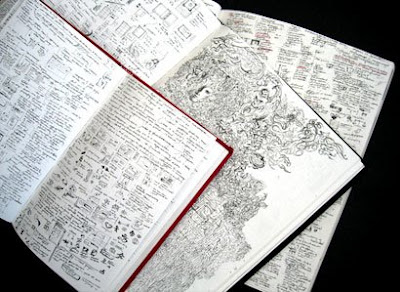
Hey hey. Thanks for stopping by. This is my very first blog (aka. Public CyberDiary). Let me start off by telling you a bit of myself. My name’s Sherrie Thai. I’m the art director of my venture, Shaire Productions, where I produce graphic design and illustration for clients. I also hold down a full-time job as a designer, but in true freelance mentality, I never believed in putting all your eggs in one basket, so I still keep side projects going (it could also be the workaholic in me too). My background is in the fine arts (drawings, glass etchings, lettering, photography and book arts)–self-taught, but have always kept it separate from the commercial design, and it eventually fell on the back-burner. For many years, I’ve only focused on the commercial aspect of design–mainly for survival–but now, my outlook has become more introspective. The fine arts mentality of “do what you will” has been peeking through more steadily and has fueled me to straddle both commercialism and fine arts expressionism. I’ve been searching for alternative creative outlets; this blog is one method.
Another is my website. I’ve been so busy for the last 10 years working away on client projects that I’ve never had a chance to work on my personal site. Right now, I only have a free site through Coroflot. . . but with more time available, I’ve decided to concentrate specifically on my website, and although it leaves less time for other things, it’s been very fulfilling . . . so stay tuned for an interactive book portfolio in the coming months!
There has been encouraging news within the last couple of weeks that I just can’t contain. I was involved with the design of an online eldercare site (AGIS) which has received an Honorary Nomination for a Webby Award this year. Whoohoo! The same day, I received word that one of my photos would be part of a California Tour Guide. I’ve always enjoyed taking photos, but never thought it would be published. Check it out: Schmap California Events
One of the most encouraging news was a mention in a design tutorial and an inclusion of my sketchbooks. Role of Sketching in the Design Process by Sean Hodge is a discussion on the importance of conceptualizing through sketching. I was honored to have discovered my inclusion in the article, as I wholeheartedly agree with the importance of sketching during the design process. Unfortunately, I’ve noticed a decline with some designers when it comes to developing ideas on paper. It’s not all about having the best and cleanest drawings as it is about working through and developing your ideas. I have tried going straight to the computer to knock stuff out, but I’d have a creative block and struggle with the work for hours. I started changing my routine and spent some time sketching out ideas and noticed I was able to cut down on the production time. Art is about experimentation and experience; conceptualizing at the start helps to organize thoughts in a more linear fashion. I suppose I may be a purist in upholding the design process.
Anyway, hope to update this blog with something new each week. . .







